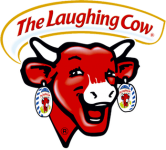Offline
La vache qui rit - the laughing cow. And we've usually seen it on packaged cheeses, right?

I sure was surprised when I learned the origin of that symbol. It first appeared on the side of a supply truck which brought fresh meat (!) to French troops during WW1.

And inside, the (formerly) laughing cows:

During WW1 the laughing cow on the truck's side was called the "Walchkyrie" - a play on words for the German "Walkuer" (goddess who chooses the victors in a battle). The French - quite naturally! - pronounced it "vache qui rit" - the laughing cow. Soon after the war, the symbol (and the French pronunciation) was used for a new line of factory-processed cheeses.
And now you know, the rest of the story.
Tom M.

I sure was surprised when I learned the origin of that symbol. It first appeared on the side of a supply truck which brought fresh meat (!) to French troops during WW1.
And inside, the (formerly) laughing cows:
During WW1 the laughing cow on the truck's side was called the "Walchkyrie" - a play on words for the German "Walkuer" (goddess who chooses the victors in a battle). The French - quite naturally! - pronounced it "vache qui rit" - the laughing cow. Soon after the war, the symbol (and the French pronunciation) was used for a new line of factory-processed cheeses.
And now you know, the rest of the story.
Tom M.

 Hi Guest!
Hi Guest!

 smilie in place of the real @
smilie in place of the real @
 Pretty Please - add it to our Events forum(s) and add to the calendar! >>
Pretty Please - add it to our Events forum(s) and add to the calendar! >> 

